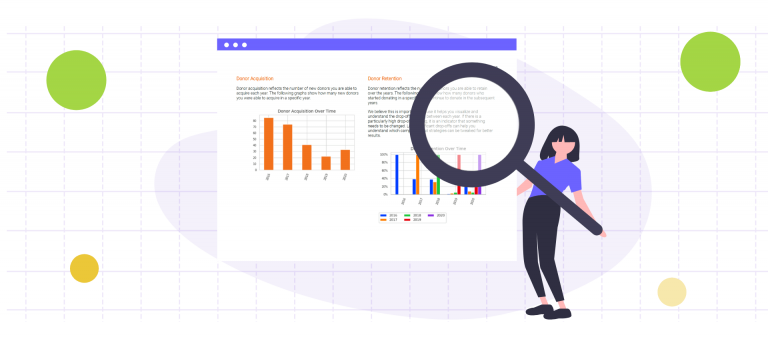A Guide to Nonprofit Financial Projections

Nonprofit financial planning is tough. You can guess, hope, and peer into your crystal ball all you want, but if you’re going to stay grounded in reality, there’s just one thing that can make your nonprofit financial projections more accurate: reliable data.
Budgeting your nonprofit organization’s programs and operations may seem like an exercise in futility. After all, how can you possibly know who is going to donate and when? But if you dig into your data and do a little math based on safe assumptions, you can arrive at a budget that will guide how your organization runs in the future. For help structuring that budget, use a nonprofit budget template guide to organize all your projected revenue and expenses – this ensures your financial forecasts translate into a realistic annual plan.
This is forecasting, and it’s absolutely essential to make sure you don’t get caught off-guard halfway through your fiscal year.
Why Forecasting Is Important
While financial forecasting for nonprofits is not going to be perfectly accurate every single time, it’s the best tool available to give you a good idea of what your organization is capable of doing, and when.
Enkel cites three primary benefits of budget forecasting in this post:
- Tracking performance. Comparing both your projections and your actual activities against your budget lets you track your financial performance. is to say, if you’re blowing through your allotted budget every time, it may be time to go back to the drawing board for your next financial plan. Conversely, if you frequently have a leftover budget at the end of a program, you can probably plan on doing more with less in the future.
- Spotting opportunities & challenges. Forecasts make it easier to plan the use of working capital around emerging opportunities and anticipated problems. Thinking about possible negative externalities in advance of actually confronting them is the best way to be ready for things to go wrong. Likewise, identifying opportunities before they happen gives you and your team the ability to be ready to capitalize on them.
- Responding to change. While new information or events can lead to a change in plans in any given year, they don’t always warrant revising your annual budget. Cash flow forecasts are an ideal tool for responding to unanticipated change.
Forecasting can help you build buffers into your budget, rather than rewriting the whole thing, that let you roll with the punches that are so common in the nonprofit sector.
How to Forecast Your Nonprofit Revenue
At a foundational level, forecasting is simply looking at your nonprofit revenue streams from previous years, then accounting for expected trends and changes in certain areas in the upcoming year (or five years, or ten). Let’s take a look at the trends that most often affect nonprofit financials.
1. Study Historic Giving Patterns
Looking at data from previous years, you should be able to identify both high and low seasons for revenue. For example, on average, across the nonprofit sector, 30% of all donations are made in December. This is good to know, but you can also go deeper.
Perhaps a nonprofit organization with an annual event in July sees its main revenue spike in June as participants ramp up fundraising. Conversely, you can likely identify a slow season when revenue is low each year. These types of data points make forecasting much more accurate and your budget easier to manage.
2. Observe Philanthropic Trends
Just like for-profit businesses, the nonprofit world is subject to trends that span the market. From changes in giving behavior overall to specific shifts in different categories of supporters, trends can affect your organization either negatively or positively, and it’s a good idea to account for them.
Joan Garry takes a high-level look at philanthropic trends and how to analyze them, and it’s certainly worth your time to read Inside Philanthropy’s take on what’s likely to happen in the 2020s.
3. Review Pending Partnership Agreements
Partnerships between your organization and suppliers, corporations, governments, and other potential funders are a great way to secure monetary and in-kind support. However, it can take a long time to sort out the details. As part of your forecasting exercise, be sure to account for these types of revenue sources in the long term, as well as the likelihood that the partnership will be realized.
4. Conduct Competition Analysis
Looking at how your competitors are doing can be a helpful way to inform your forecasting. Ahead of the pack? Great, include that in your forecast. Falling behind? No problem, account for it and work toward evening the playing field. Competitor analysis templates can make it easy for you to input data and turn it into practical insights.
Joan Garry points out that most relevant financial information on nonprofit organizations is available from Guidestar, so feel free to dig in. This is an especially useful tactic for young nonprofits that don’t have a long history of internal data to pull from.
*Bonus tip - Keep a clear balance sheet and chart of accounts!
And Now, Math
Now that you’ve gathered information on things that will affect your forecast, it’s time to get your hands dirty. We created this helpful Fundraising Forecasting Calculator to do some of the heavy liftings on your behalf.
Financial Projections and Forecasting for Small Businesses by Quickbooks
Oh, but there is one more thing: if you’re relying on just one major revenue source, no amount of forecasting is going to save you if it disappears. That’s why you need to diversify!
What is Revenue Diversification?
For nonprofit organizations, diversification means finding several sources of revenue and building reliable cash flow streams from each one. In the event that one source dries up, the rest are there to prop you up until you can replace it.
Some examples of revenue sources include:
- Government and foundation grants
- Income from programs
- Individual giving
- Corporate giving
- Sponsorships
- Events
- Recurring or monthly giving programs
- Fees for goods and/or services
- Bequests
- Interest from investments
- Tax revenue
- Membership dues and fees
For each revenue source, be sure to stick to the rule that no single grant, event, or donor should make up more than 25% of your total revenue.
What are the Benefits of Revenue Diversification?
Diversifying your revenue streams is, on balance, a good idea. However, it has potential drawbacks that may or may not apply to your organization. It’s worth it to try your best to understand the financial conditions that your organization is likely to experience and how diversification may affect your business.
Additionally, diversification shouldn’t happen at the expense of your usual donor management practices. Don’t alienate your existing income streams in favor of seeking out new ones.
That said, there are three clear benefits of diversification.
1. Risk Reduction
More sources of income mean that if one drops out, you’re less likely to have to significantly alter your operational plans to account for the change in funding. Diversification is your safety net.
2. Autonomy
Depending on a single revenue source could mean that the source has disproportionate influence over how the money is spent, which could affect the goals you’ve set and your overall mission. More sources of income mean no single supporter controls what your nonprofit organization does.
3. Visibility
Targeting a specific market for financial support may be a good way to extract resources, but it may also silo your organization, making it hard to reach other market segments. For example, a nonprofit looking to cure a disease that is working hard to solicit donations from families affected by said disease may find itself invisible to foundations, governments, or large donors that pursue more general beneficiaries.
A diverse portfolio of funders means that your message and brand are spread farther, reaching potential donors in a wide array of fields who may think of you when it’s time to sign the checks.
Next Steps
First, download our fundraising forecasting calculator.
Once you’ve filled it in, if any single source constitutes more than 25% of your revenue, it’s time to diversify. But don’t freak out; remember that a high percentage of income from one source is a risk, not a disaster. It just means you’ve done a really great job in that one area, and it’s time to shift your focus a little bit.
So don’t scale back on that revenue stream. Instead, work to amplify other streams and seek out new ones to boost your portfolio. And, of course, make sure that you’re forecasting well into the future so that you know what’s coming.
Next, consider using Keela's intuitive forecasting tool to make data-driven decisions about your nonprofit's budgeting and fundraising programs.
Our forecasting tool shows you the cumulative donation total you've received in your current fiscal year, calculates how much you can expect to receive throughout the year, and predicts the time of year you're likely to receive the most donations. Powered by Keela Intelligence, this tool helps you predict your fundraising trends and plan accordingly.
.svg)



